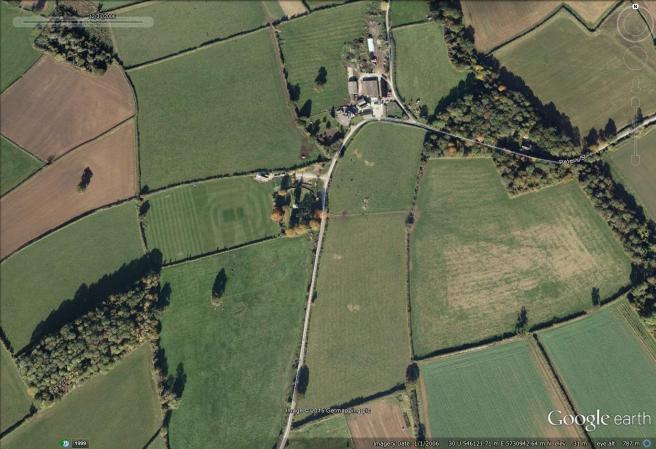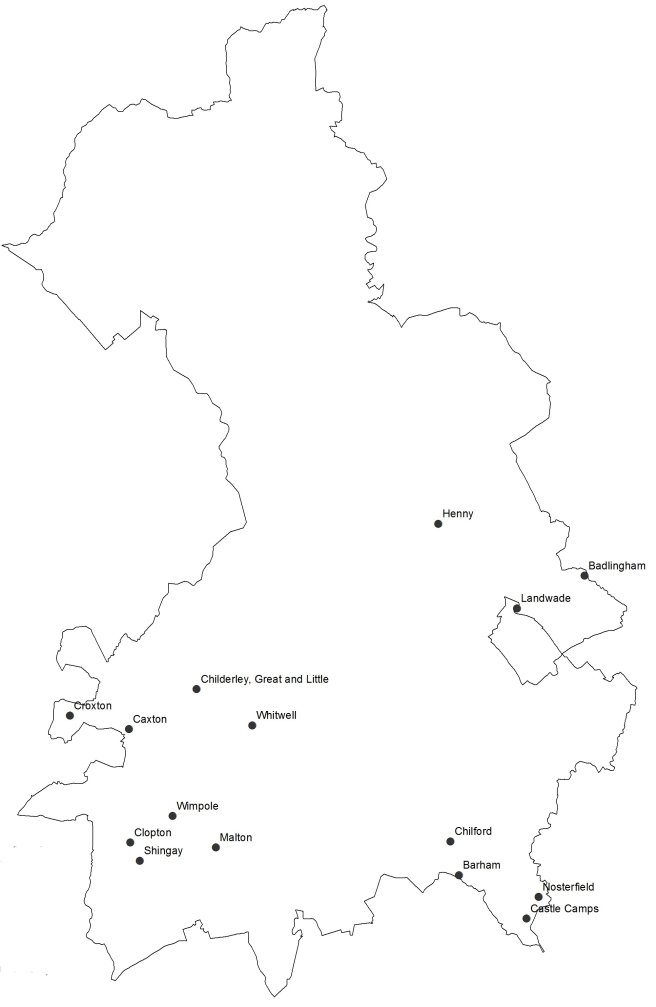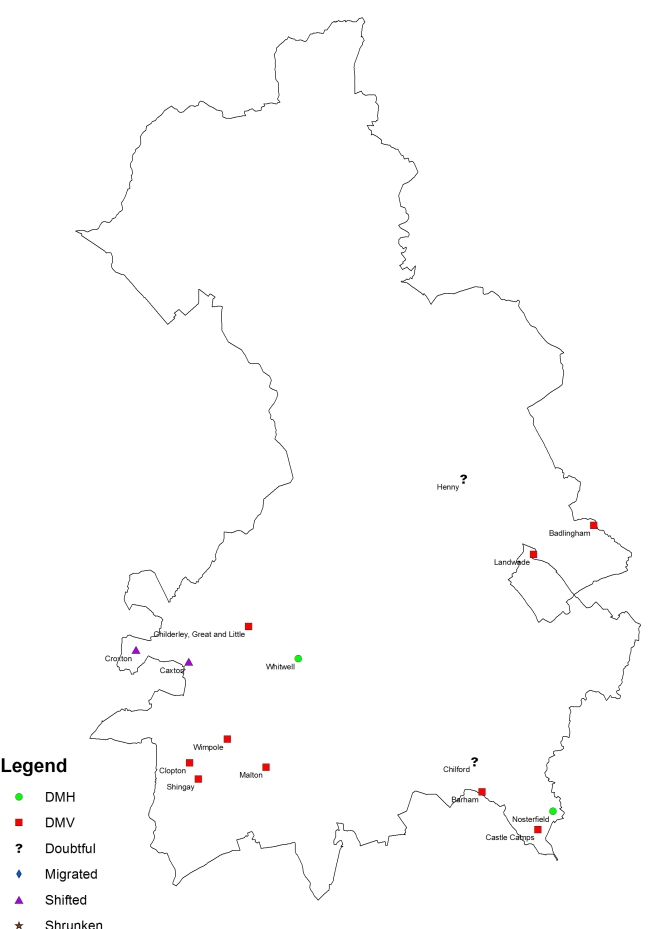This week we look at one of the completed counties on the Beresford’s Lost Villages Website. This website lists all the settlements recorded by 1968 and gives a full description of the available evidence.
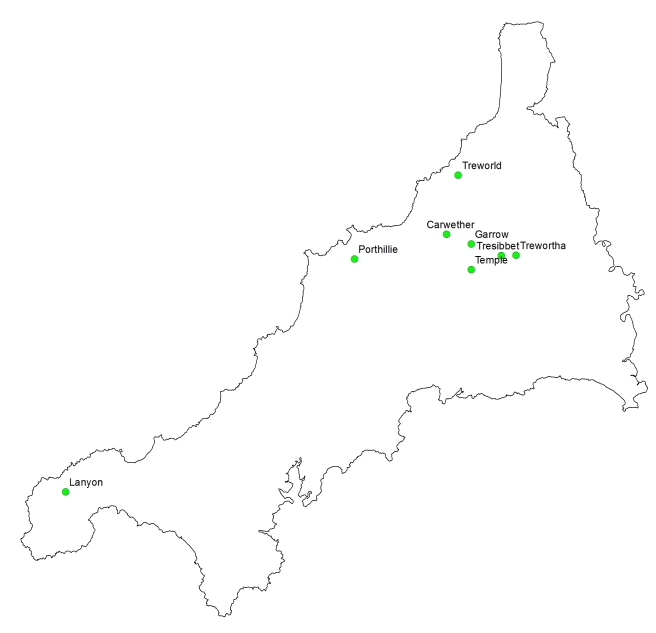
No Cornish settlements were included when Maurice Beresford published his Lost Villages of England in 1954. This was not due to any lack of information but due to a slight publishing oversight. The list for Cornwall was later found slipped down the back of the piano when Maurice was moving in 1958 (Beresford 1971: 3). A total of 11 sites were recorded on the 1968 Gazetteer. Cornwall is highlighted as one of the 15 counties which require considerable local research, but it is unclear why some sites that had been identified in the 1960s did not make the original Gazetteer (Dudley and Minter 1962-63: 282-283). Since 1968 there has been sustained effort placed in surveying areas of the historic environment including one of the first examples of a county-wide history landscape characterisation (Herring 1998). The large-scale survey of Bodmin Moor by the RCHME has also been important to our understanding medieval Cornwall (Johnson and Rose 1994, Preston-Jones and Rose 1986: 139).
The landscape of current settlement in Cornwall (at least that on the first edition Ordnance Survey maps) has been said to reflect the medieval pattern of small hamlets and farmsteads (Preston-Jones and Rose 1986: 141). This dispersed settlement pattern is interspersed with closes (enclosed fields) and small-scale open fields (Rippon and Croft 2011: 195). The pattern though is varied and in some areas nucleated villages do dominate (Overton 2006: 109). The settlement form in Cornwall also varies, and many of the deserted sites consist of a cluster of buildings, sometimes with their own yards, but not the format of toft and croft seen in central England, and perhaps not the label of ‘village’. Hence the website has classed most of the settlements in Cornwall as deserted hamlets.

With this diversity of settlement evidence there has been a diversity of approaches to the study of settlement in the county but in many ways this has led the research in England as a whole. Two pioneers in the study of deserted settlement not only in the South West, but also in England, were Dorothy Dudley and E. Marie Minter. They excavated a number of sites in both Cornwall and Devon. In fact Cornwall has seen some of the earliest excavations of village sites in the country.

Of the 11 sites identified in 1968, four sites had been excavated by the time of the Gazetteer. Excavations in 1891-2 at Trewortha have been classed as one of the earliest excavations of a deserted medieval settlement, even if it was not identified as such at the time (Baring-Gould 1895a, 1895b). Initially excavated as it was thought to be evidence of prehistoric settlement, the only date that was given by the excavations was post-Roman (Baring-Gould 1895a, 1895b). The excavation revealed the remains of a number of stone buildings, typical longhouses of the area, although a more complex interpretation of a council house was given at the time (Baring-Gould 1895a).
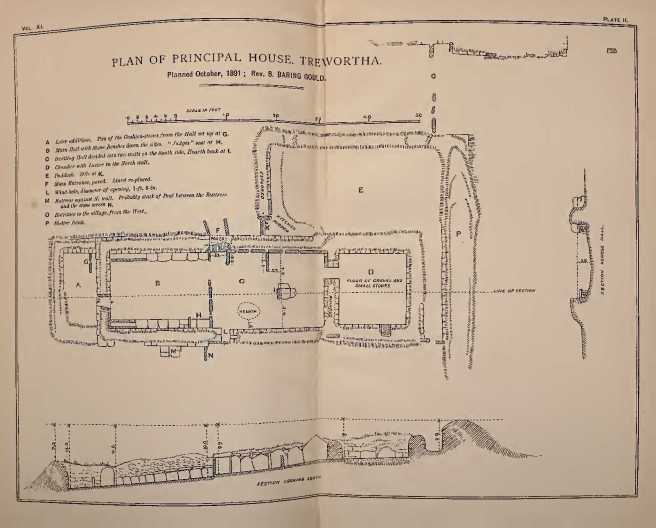
Dorothy Dudley and E Marie Minter worked together on a number of sites. In 1952 they excavated at Garrow looking at one house which they dated to the thirteenth to fifteenth century (Dudley and Minter 1962-63). Treworld in north-east Cornwall was excavated in 1963. A number of phases of activity were identified, with stone houses suggested from A.D. 1200. However preceding this has been a much debated phase which is said to consist of turf houses (Dudley and Minter 1966). In 1964 the site of Lanyon was excavated which revealed stone buildings from the twelfth century (Minter 1965, Beresford 1994).
More recently, the RCHME undertook detailed surveys of Garrow, Trewortha Marsh and Carwether as part of their survey of Bodmin Moor (Johnson and Rose 1994).
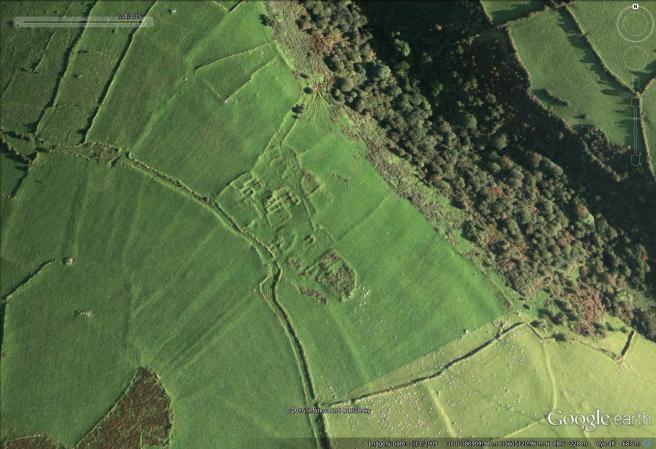
Many of the excavated sites, as well as those listed on the website, have been concentrated on what has been classed as marginal or secondary sites – areas which have seen settlement expansion (Preston-Jones and Rose 1986: 151). More research is needed in the lowland areas, the documentary evidence points to at least 750 settlements that are mentioned but have since been deserted (Preston-Jones and Rose 1986: 151).
A number of projects have been undertaken making public the information held by the Cornwall HER – they include a range of aerial photographs that can accessed at the Flying Past website at http://www.historic-cornwall.org.uk/flyingpast/. Many of the settlements on the website have excellent photos here….
References
Baring-Gould, S. 1895a. ‘An Ancient Settlement of Trewortha Marsh’, Journal of the Royal Institution of Cornwall 11: 57-70.
Baring-Gould, S. 1895b. ‘Ancient Settlement of Trewortha’, Journal of the Royal Institution of Cornwall 11: 289-90.
Beresford, G. 1994. ‘Old Lanyon, Madron: a Deserted Medieval Settlement. The Late E Marie Minter’s Excavations of 1964’, Cornish Archaeology 33: 130-169.
Beresford, M.W. 1954. The Lost Villages of England. London: Lutterworth Press.
Beresford, M.W. 1971. ‘A Review of Historical Research (to 1968)’, in M.W. Beresford and J.G. Hurst (eds.) Deserted Medieval Villages: Studies: 3-75. London: Lutterworth.
Dudley, D. and E.M. Minter 1962-3. ‘The Medieval Village at Garrow Tor, Bodmin Moor, Cornwall’, Medieval Archaeology 6-7: 272-294.
Dudley, D. and E.M. Minter 1966. ‘The Excavation of a Medieval Settlement at Trewold. Lesnewth, 1963’, Cornish Archaeology 5: 34-58.
Herring, P. 1998. Cornwall’s Historic Landscape: Presenting a Method of Historic Landscape Character Assessment. Truro: Cornwall Archaeological Unit.
Johnson, N. and P. Rose 1994. Bodmin Moor: An Archaeological Survey Volume 1: the Human Landscape to c. 1800. London: English Heritage.
Minter, E.M. 1965. ‘Lanyon in Madron: Interim Report on the Society’s 1964 Excavation’, Cornish Archaeology 4: 44-45.
Overton, M. 2006. ‘Farming, Fishing and Rural Settlements’, in R.J.P. Kain (ed.) The South West: 109-130. London: English Heritage.
Preston-Jones, A. and P. Rose 1986. ‘Medieval Cornwall’, Cornish Archaeology 25: 135-185.
Rippon, S. and B. Croft 2007. ‘Post-Conquest Medieval’, in C.J. Webster (ed.) The Archaeology of South West England: South West Archaeological Research Framework Resource Assessment and Research Agenda: 195-203. Taunton: Somerset County Council.


